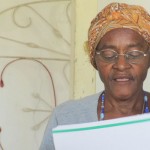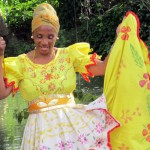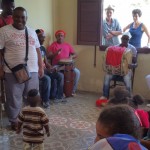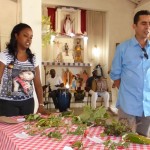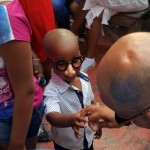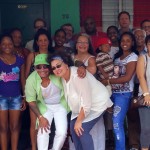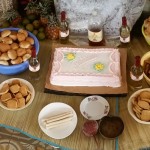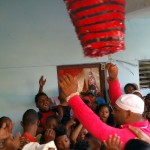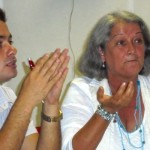Academics and Lifelong Learners Experience Afro-Cuban Cultures and Religions
In March 2016, academics and lifelong learners experienced Afro-Cuban cultures and religions through a collaborative workshop sponsored by Civitas GES. The workshop was held jointly at the Universidad de Cienfuegos and the Lucumí/ Congo religious societies in Palmira from March 6 to 13, 2016. Using the concept of “experiential learning” as its framework, participants learned about the topic in university classrooms with specialists in the field, and then spent each afternoon directly engaged with the community in Palmira doing hands-on activities. Both academics and life-long learners found the program beneficial because it provided an in-depth look at a rich but little known aspect of Cuban culture, the African experience in Cuba.
Classes covered the history of Africans in Cuba, including their eventual integration into Cuban culture during the colonial period and the racial tensions that existed after slaves gained their freedom in the late 19th century. We discussed topics such as race and ethnicity in the construction of national identity and we looked at the contributions of Afro-Cubans to literature, art, music and dance. We learned about different religions that came to Cuba from Africa, such as Regla de Ocha (Santería) and Regla de Congo (Palo Monte) and the creation of “cabildos” or mutual aid societies for Cuban blacks in the early 20th century. In addition, we learned to sing and dance to African rhythms in special classes led by talented professionals who are on the faculty at U of Cienfuegos.
In Palmira, we visited a different religious society each day: El Cristo, Santa Bárbara, San Antonio, and San Roque, four of the oldest and most traditional Afro-Cuban cabildos in Central Cuba. At each place, the president of the organization and many members of the association greeted us warmly and explained the history of the society and its founders. We saw drumming, dancing and singing demonstrations, and had the opportunity to join in with the community in the ceremonies. We participated in hands-on workshops about the use of herbs for medicinal purposes, the preparation of adimus (ritual food) and the special clothing used in Santería ceremonies. In addition, we visited, with almost half the town of Palmira, a nearby river, where we held a tribute to Ochun, the orisha of love and beauty, with more dancing, singing and drumming and, of course, food! We visited the botanical garden and city museum in Palmira, where we learned more about the history of the town and the importance of herbal medicine in local culture. Our week culminated with a “piñata” party for the children of the town, and another drumming ceremony in honor of Elegua, the owner of the crossroads, with expressions of hope that this will be the first of many future encounters between Americans and Cubans who come together in friendship and solidarity to learn about each other’s cultures.
- The granddaughter of El Cristo’s founder explains the preparation of adimus or ceremonial foods for the Orichas.
- Drummers, singers and dancers accompany the community to the river to pay homage to Ochun. Nature plays an important role in the religion and religious ceremonies sometimes take place outdoors as a way to remind people of the relationship between nature, human beings, and the Divine. The drums’ vibrations awaken and call Ochun, who then makes her presence known by possessing the dancer and guiding her movements.
- A folkloric dancer represents Ochun, the Oricha of femininity, love and fertility at the riverbank. Ochun dresses in yellow and carries a fan. Ochun is the most beautiful of the female Orichas.
- Founded in 1879, Palmira is one of eight municipalities within the Province of Cienfuegos. It is home to some of the oldest continuous sociedades for Santeria in the country including: El Cristo, Santa Barbara, San Roque and San Antonio de Los Congos.
- All tambores (drumming ceremonies) are done in a specific order in tribute to the Orichas. It’s only fitting that this young one leads off the dancing at San Roque as Elegua is always the first Oricha in the tribute lineup.
- Vice President for the Sociedad El Cristo, Malena Capote, leads a discussion on the use of herbs in traditional medicine and in the practice of Regla de Ocha, commonly known as Santeria at Sociedad El Cristo. Many of these traditional medicines have been adapted for use in pharmaceuticals today.
- Class participant, David Febus, assists a new friend with his recently acquired party favor after the Piñata for Elegua.
- Marlon Capote welcomed the class to lunch at his home on the final day of the program. Mr. Capote is Vocero (public relations director) for the Sociedad El Cristo.
- The ritual offering and drumming ceremony for Elegua was held on the final day at Sociedad San Roque. Elegua likes cigars, rum and sweets. After the ceremony, the food is distributed among the attendees and consumed. It’s considered a blessing to eat food that has been offered first to the Orichas.
- A folkloric dancer dressed in a representation of the Oricha, Elegua, involves lifelong learner, Gerri Bohanan, in his performance. Elegua’s personality is commonly associated with childlike behavior; he enjoys candy, toys and playing practical jokes. Elegua opens and closes paths in life, thus all tributes and ceremonies begin and end with him.
- An Ebo de Estera (offering) is made near the river as part of the Homanaje a Ochun (Tribute to Ochun). The Homanaje included music and dance. Ochun is the most beautiful of the female Orichas and exhibits all of the characteristics associated with fresh flowing water: she’s lively, sparking, vivacious, refreshing.
- A piñata for Elegua at Sociedad San Roque in Palmira closed out the activities for the day and the weeklong experience. Class participants brought candy, toys, school supplies and other party favors with them to stuff the piñata.
- Universidad de Cienfuegos Professor Lisbel Fumero (with the assistance of a translator) leads a discussion about Afro-Cuban literature.


